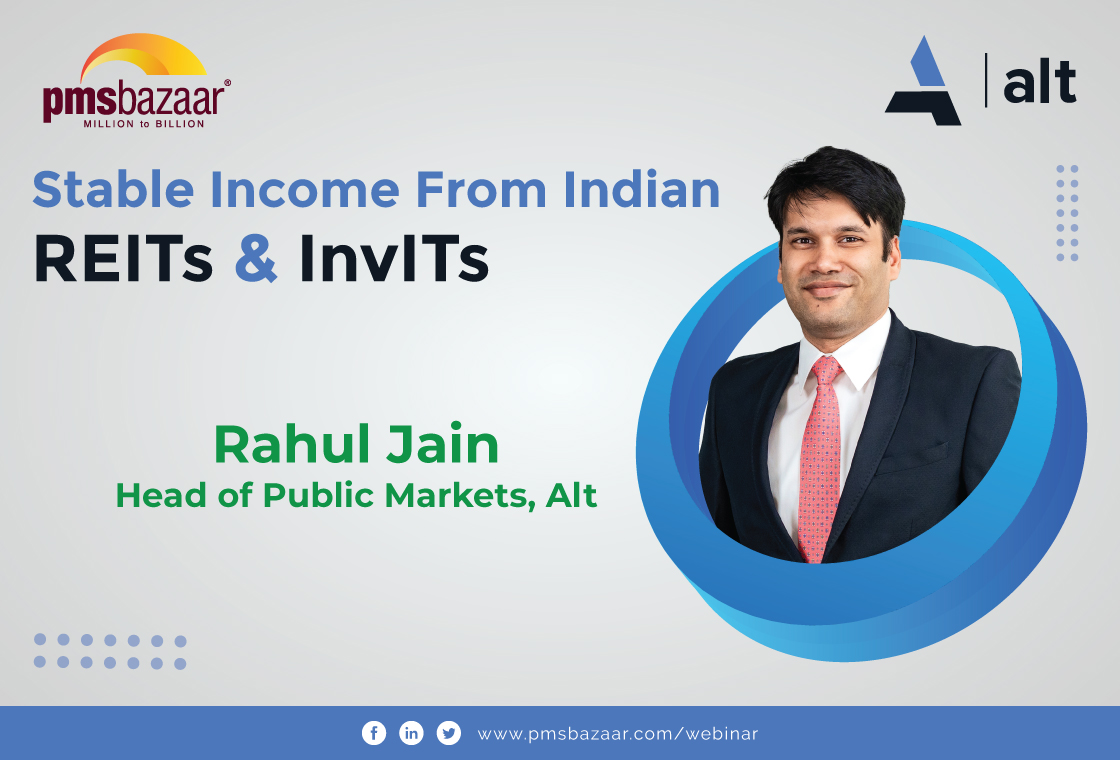Growth-oriented and pro-development, India’s Union Budget 2022-23 seeks to lay down the foundation of the economy for the next 25 years. Despite multiple waves of COVID-19 infection, supply-chain interruptions, and inflation, the Indian economy is anticipated to increase at a pace of 9.27% this fiscal year, indicating that overall economic activity has recovered from pre-pandemic levels.

The Union Budget 2022-23 is built on four core pillars with the goal of boosting domestic manufacturing and creating jobs after a two-year surge in unemployment.
- Inclusive Development
- Productivity Enhancement
- Financing Investments and
- PM GatiShakti.
In this very interesting backdrop, PMS Bazaar held a special webinar “Budget Analysis and Morningstar’s Market Outlook 2022”. The keynote speaker Mr. Dhaval Kapadia, Director, Managed Portfolios, Morningstar Investment Adviser, India decoded the fine print of the Union Budget 2022 and shared his point of view on the major tax and policy changes. The webinar entailed detailed impact analysis and the way forward for the businesses.
The Key inputs and insights concerning the Union Budget 2022 as given by Mr. Dhaval covered in this webinar blog are
- The core theme of the budget
- Different schemes expansion (ECLGS & PLI)
- Fiscal deficit projection FY 23
- Impact of the Union Budget on different sectors
Core Theme of the Budget
The Union Budget 20220 focused primarily on capital expenditure to try and boost the economy along with social sector initiatives which are very essential - whether it is around health education or water and so on.
The capital expenditure budget set aside in the current fiscal year has increased by 20-25% compared to the previous year. This is a substantial increase in capital expenditure spending and most of this is targeted toward building more roads, and highways, and extending the railway network, among others.
Hence, the driving factor of this budget is capital expenditure and that's how the government thinks the economic growth could revive and sustain over a period.
Conservative Gross Domestic Product
According to Mr. Dhaval, “If you look at the GDP growth that has been projected in the budget right now to derive revenue projections and other projections, the projection or estimation seems to be a little bit conservative now. This is the normal GDP growth rate so it includes inflation as a component”.
The budget projection for GDP growth rate is around 11% whereas the Reserve Bank of India itself is projecting the current year GDP to be around 13% to 13.5%. So the government seems to have been a little bit conservative in its projection for growth rate when it comes to the economy as a whole.
Extension of Emergency Credit Line Guarantee Scheme (ECLGS)
Some of the schemes which have worked well during the pandemic such as the Emergency Credit Line Guarantee Scheme (ECLGS) scheme which was essentially providing a guaranteed cover for small and medium enterprises (SMEs) so that SMEs are in a better position to borrow money and banks are more comfortable lending to them.
The Budget 2022 announced the extension of ECLGS till March 2023. The cover of the scheme will be expanded by INR 50,000 crore to INR 5 lakh crore.
An additional amount has been earmarked exclusively for hospitality, and related sectors and the government will take steps to make the MSME (Micro, Small, and Medium Enterprises) sector more resilient, she added. The government had launched the scheme in view of the Covid-19 pandemic to provide credit facilities to business enterprises, and small and medium businesses (MSMEs).
Digital Currency and Taxation of Cryptocurrency
The Union Budget has brought much-needed clarity for millions of crypto investors in India. The government has imposed a 30% fixed tax rate on all income generated through crypto trading while also aiming to introduce the Digital Rupee in 2022–23.
We have seen a multifold rise in digital currency investors since 2020. A tax regime for digital currency was expected in the Budget 2022 due to prevailing ambiguity. “On the one hand, there was a law to pay tax on such income, and on the other hand, the government had sent notices to the investors who skipped reporting and paying taxes on crypto income last year. This led to confusion amongst taxpayers regarding how they go about paying taxes on income from such digital assets”, says Mr. Dhaval.
Announcement of Production Linked Incentive Scheme (PLI)
The PLI announced by the government in 14 sectors will create 60 lakh jobs and has the potential to generate ?30 lakh crore in production over the next five years. The PLI scheme, which has been announced for sectors including telecom, auto, and pharmaceuticals, has received an excellent response. It could be to boost exports, while for others, it could be aimed as import substitution towards becoming Atma Nirbhar (self-sufficient).
The 13 key sectors include three already existing sectors: mobile manufacturing and specified electronic components; critical key starting materials/drug intermediaries and active pharmaceutical ingredients; medical device manufacturing; and ten new key sectors approved by the Union Cabinet in November 2020.
Additionally, under the existing PLI system, the government promised additional allocations for the telecom and solar sectors. A scheme for design-led manufacturing will be established to create a robust ecosystem for 5G. The statement came as part of the government's aim to auction the 5G spectrum this year to begin rolling out 5G mobile services across the country.
“The PLI scheme is sort of positive from a point of view that over the last few decades India has not really grown too much on the manufacturing side, although the services sector has done well. However, the services sector can employ only a certain number of people right while the manufacturing sector. So, it is good to see that the government is trying to make its space in manufacturing”, claims Mr. Dhaval.
Fiscal Deficit
The government has estimated India's total expenditure at Rs 39.45 lakh crore and projected fiscal deficit at 6.4% of GDP for FY23.
The fiscal deficit for the current year is estimated at 6.9% and it will be about 6.4% in the next year, which is on the higher side compared to the fiscal deficit estimated in the last few years, it is less than the current year fiscal deficit estimation.
Post the pandemic last couple of years the government has to try and boost or support the economy, hence they have chosen to expand the fiscal deficit which is probably the right move needed to support the economy. However, the government has laid down the consolidation path over which they intend to reduce the fiscal deficit over the next few years.
Impact of Budget 2022 on different Sectors as Decoded by Mr. Dhaval
Financials
- Higher capex will push and support the MSME sector to increase credit offtake which has been subdued amid the pandemic.
- The digitisation push would increase outreach for financial institutions.
- IBCs amendments to help in faster resolution of NPAs and likely reduce provisions.
- No announcement on the recapitalisation of banks as balance sheets are stronger and asset quality has improved
Capital Goods
- Increased capex push to benefit companies via higher-order flows.
- Removal of concessional customs duty would boost competitiveness for domestic manufacturers as imports would get costlier
Cement
- Increased Capex on transport & roads, housing support, and undertaking of drinking water projects to boost demand for cement.
- Cement consumption is expected to pick up to 420 to 450 mn tonnes by FY 2027 with CU being close to 80% of the present capacity.
Industrials
- A strong infrastructure push via a sharp increase in Capex is expected to boost order flows for EPC and industrial companies.
Power
- An increase in PLI allocation and import duties will provide a thrust for local manufacturers.
- Green Bonds will enable access to lower long-term funding costs for renewable and clean energy projects.
Metals
- The increase in outlay for capital expenditure may provide the much-needed impetus to the mining and metals (M&M) industry which forms the backbone around which blueprints for capital expenditure are drawn up.
- The pilot projects for coal gasification and conversion of coal into chemicals will boost the transition to a carbon-neutral economy.
- A slew of measures has also been announced from an indirect tax perspective such as an extension of customs duty exemption on the import of steel scrap by another year (up to 31 March 2023) and revocation of anti-dumping and countervailing duty on specified steel products.
Pharma and Healthcare
- An increase in Capex will lead to improvement in coverage of health services.
- The increased allocation is likely for the development of bulk drug plants to reduce dependency and lower supply chain risks for key raw materials.
- Digitising patient records could enable faster and better services.
Oil and Gas
- Subsidy provision may see a rise if fuel price rises further.
- Additional excise duty is to promote the blending of fuel with ethanol/bio-diesel which enhances fuel combustion efficiency and reduces carbon emissions and results in lower fuel imports
Agriculture
- The sharp decline in fertiliser subsidy would adversely hit the farming sector which is already ailing under a shortage of fertilisers
Automobiles
- Capex will boost production in the electric vehicle space.
- Increased infrastructure spending will have an indirect positive impact on auto and ancillaries
- The high Capex push is positive for the CV segment.
Consumer durables
- Water supply to households can spur demand for durable products such as washing machines and water purifiers.
- Solar capacity expansion will improve the affordability of solar energy for consumers.
Real estate
- An increase in Capex will provide affordable housing to the middle class and economically weaker sections of the society
Telecom
- Receipts show a decline over a higher base in FY 22 which was the result of the AGR liability dues paid by telecom operators.
- Improved connectivity to aid digital penetration nationwide
Mr. Dhaval Kapadia covered all the above-mentioned topics in-depth and also answered some questions from the audience towards the end of the session. Watch the recording of this insightful session through the appended link below:
Get access to rich data and analytics of PMS & AIF by subscribing to us. Join the 37000+ investors & experts now: https://pmsbazaar.com/Home/Login
Recent Blogs
.jpg)
Passively Active Investing — A Modern Investor’s Lens on ETF-Based PMS
PMS Bazaar recently organized a webinar titled “Passively Active Investing — A Modern Investor’s Lens on ETF-Based PMS,” which featured Mr. Karan Bhatia, Co-Founder and Co-Fund Manager , Pricebridge Honeycomb ETF PMs. This blog covers the important points shared in this insightful webinar.

Spot the Trouble: Red Flags in Equity Investment Analysis
PMS Bazaar recently organized a webinar titled “Spot the Trouble: Red Flags in Equity Investment Analysis,” which featured Mr. Arpit Shah, Co-Founder & Director, Care Portfolio Managers. This blog covers the important points shared in this insightful webinar.

Long-Only AIFs Rebound Sharply in October; Long-Short Strategies Lag Despite Lower Volatility
106 long-only AIFs averaged 3.68% vs 32 long-short AIFs at 2.7%; only 24–31% of funds beat key indices

Markets log strongest monthly gains in 7 months; PMS performance turns near-uniform in October
Nifty 50 TRI gained 4.62%, BSE 500 TRI rose 4.27%; 415 of 427 equity PMSes ended positive

How SMEs are Shaping India’s Investment Landscape?
PMS Bazaar recently organized a webinar titled “How SMEs are Shaping India’s Investment Landscape?” which featured Mr. Shrikant Goyal, Fund Manager, GetFive Opportunity Fund.

Stable Income from Indian REITs and InvITs
PMS Bazaar recently organized a webinar titled “Stable Income from Indian REITs and InvITs,” which featured Mr. Rahul Jain, Head of Public Markets, Alt.

5 Key Considerations Before Investing in AIFs in India
Alternative Investment Funds (AIFs) have emerged as a compelling option for sophisticated investors seeking diversification and potentially superior returns. But venturing into AIFs requires a clear understanding of their unique characteristics that go beyond simply knowing what they are and their categories.

How AIF can help in diversification?
Traditionally, Indian investors have relied on a mix of stocks and bonds to build their wealth. While this approach offers diversification, it can still leave your portfolio vulnerable to market fluctuations. Enter Alternative Investment Funds (AIFs), a dynamic asset class gaining traction for its ability to unlock diversification beyond the realm of conventional options.

